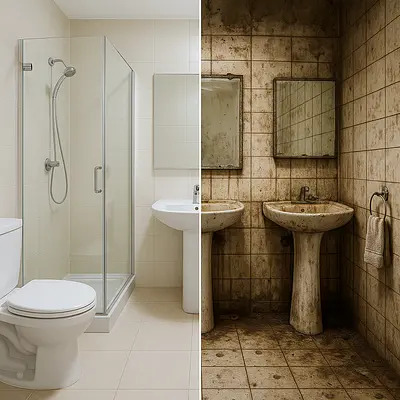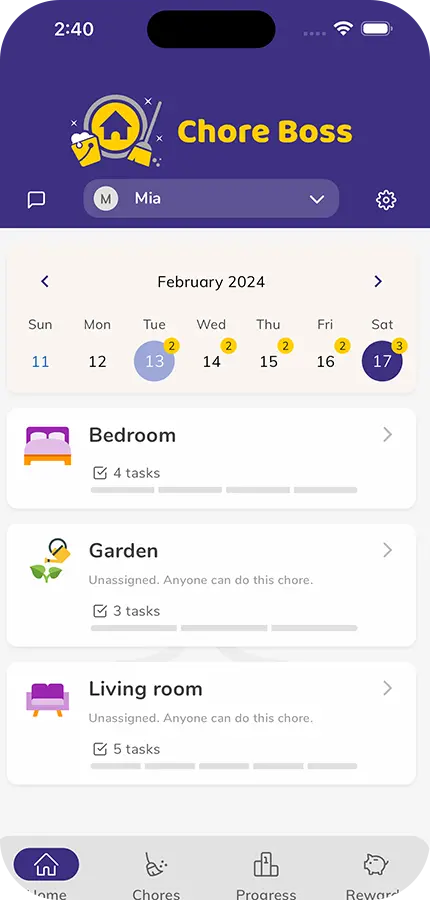Hey there, fellow parents! Let's talk about something that might make you squirm a little – but trust me, understanding the science behind bathroom germs will transform how your kids think about cleaning this important space.
We've all been there: standing in the bathroom doorway, surveying the aftermath of our children's "quick" bathroom visit, wondering how such small humans can create such impressive chaos. But here's the thing – teaching our kids about bathroom hygiene isn't just about keeping things tidy. It's about understanding the fascinating (and slightly gross) science of germs and why this knowledge can actually empower them to take ownership of their health and home.
The Invisible World Living in Your Bathroom
Let's start with a mind-blowing fact that always gets kids' attention: every surface in your bathroom is home to millions of microscopic organisms. I know, I know – it sounds scary! But here's how I like to explain it to children: think of germs like tiny, invisible pets that live everywhere. Some are helpful (yes, really!), some are harmless, and some can make us sick if we don't manage them properly.
The bathroom is particularly interesting to these microscopic "pets" because it offers everything they love: - Moisture from showers and sinks - Warmth from our body heat and hot water - Food sources (dead skin cells, soap residue, and... well, other things) - Dark, undisturbed spaces where they can multiply happily
The Fascinating Science Behind Common Bathroom Germs
The Toilet: A Germ Metropolis
Here's where it gets really interesting for curious kids. Every time someone flushes the toilet, something called a "toilet plume" occurs – essentially, a invisible cloud of water droplets containing bacteria shoots up to 6 feet in the air! These droplets can land on: - Toothbrushes - Towels - The sink - Even the ceiling!
Kid-friendly explanation: "Imagine the toilet is like a tiny volcano that erupts invisible lava every time you flush – that's why we always put the lid down first!"
The Shower: Where Biofilms Party
That pink or black film you sometimes see in shower corners? That's called a biofilm – basically, a germ apartment complex where different types of bacteria and fungi live together. The most common resident is Serratia marcescens, which creates that pink slime.
Kid-friendly explanation: "It's like germs building their own little cities in the corners of our shower – and just like any city, it grows bigger if we don't clean it up!"
Door Handles and Faucets: The Germ Highways
These high-touch surfaces are like busy highways for germs, transferring them from person to person throughout the day.
Why This Science Matters: The Health Connection
Now, before you or your kids start panicking, let me share some reassuring science: most bathroom germs are actually harmless to healthy people. Our immune systems are incredibly good at dealing with everyday bacteria. However, some germs can cause:
- Stomach bugs
- Skin infections
- Respiratory issues
- Urinary tract infections
The good news? Regular cleaning dramatically reduces harmful bacteria levels – we're talking about a 99% reduction with proper cleaning techniques!
Making Germ Science Fun and Educational
Experiment Time!
Here are some safe, kid-friendly experiments to make germ science tangible:
The Glitter Germ Experiment 1. Put glitter on your hands (this represents germs) 2. Go about normal bathroom activities 3. See where the "germs" end up 4. Show how proper handwashing removes the glitter
The Bread Mold Test 1. Touch one piece of bread with unwashed hands 2. Touch another piece after proper handwashing 3. Seal both in bags and observe over a week 4. Compare the mold growth!
Age-Appropriate Explanations
For younger kids (4-7): Focus on the "good guy vs. bad guy" narrative. "We're like superheroes keeping the bad germs away so our family stays healthy!"
For older kids (8-12): Introduce basic microbiology concepts. Explain how soap molecules actually work to break down bacterial cell walls – it's like having tiny Pac-Men eating the germs!
For teens: Discuss the connection between personal hygiene, public health, and even antibiotic resistance. They're old enough to understand the broader implications.
Creating Positive Cleaning Habits Through Understanding
When kids understand the why behind bathroom cleaning, they're more likely to develop intrinsic motivation. Here's how to build on that scientific foundation:
Make It a Detective Game
"Let's be germ detectives and find all the places germs like to hide!"
Create a "Germ-Busting" Routine
- Hot water and soap for handwashing (explain how heat helps break down bacterial walls)
- Disinfectant wipes for surfaces (talk about how different chemicals target different types of germs)
- Proper ventilation (explain how air circulation makes it harder for germs to settle and multiply)
Celebrate the Science
"Look how the mirror sparkles now – that means we removed thousands of bacteria!"
The Long-Term Benefits
Teaching kids about bathroom germ science creates lifelong benefits: - Critical thinking skills about cleanliness and health - Responsibility for their personal environment - Understanding of cause and effect - Confidence in their ability to maintain a healthy space - Respect for the invisible world around them
Practical Tips for Parents
- Start small: Focus on one concept at a time
- Use visual aids: Microscope images, educational videos, or even apps that show bacteria
- Make it routine: Incorporate germ talk into regular cleaning time
- Stay positive: Frame it as empowerment, not fear
- Lead by example: Show your own curiosity about the science
Wrapping Up: Science Makes Everything Better
The beautiful thing about teaching kids the science behind bathroom cleaning is that it transforms a chore into an adventure. Instead of "because I said so," you're giving them real, fascinating reasons to care about their environment.
Remember, we're not trying to create germaphobes – we're raising scientifically literate kids who understand that knowledge is power, and that taking care of their space is taking care of themselves and their family.
When your child understands that they're literally fighting invisible battles and winning every time they clean, bathroom maintenance becomes less of a chore and more of a victory. And honestly? That's pretty amazing.
Managing all these new cleaning routines and making sure everyone stays on track can feel overwhelming, but you don't have to do it alone! *Chore Boss** is a free app designed to help families organize household tasks with customizable chore assignments, helpful reminders, and even a virtual piggy bank to track allowances. It's a fun way to teach kids responsibility and money management while keeping your home running smoothly. Why not give it a try and make those germ-busting routines even more rewarding?*






